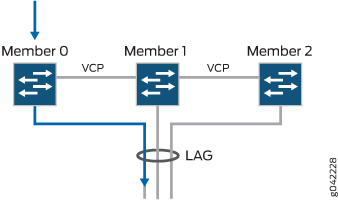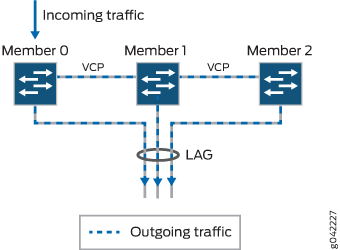Local Link Bias
Learn about local link bias, local minimum links, and how to configure local link bias.
Local Link Bias Overview
Local link bias is a feature that saves bandwidth on Virtual Chassis Ports ( VCPs). It achieves thissaves bandwidth by ensuring that unicast traffic leaving a Virtual Chassis (VC) or Virtual Chassis Fabric ( VCF) uses a local link whenever possible. A local link is a member link within a Link Aggregation Group (LAG) bundle that resides on the same member switch that received the traffic.
When local link bias is active, the traffic is both received and forwarded on the same member switch. This prevents theReceiving and forwarding on the same member switch prevents the traffic from traversing the VCPs to exit through a link on a different member switch, thereby conserving VCP bandwidth. The traffic flow of traffic exiting a Virtual Chassis or VCF over a LAG bundle when local link bias is enabled is illustrated in Figure 1.

When local link bias is disabled, egress traffic exiting a Virtual Chassis or VCF on a LAG bundle can be forwarded out of any member link in the LAG bundle. Traffic forwarding decisions are made by an internal algorithm that attempts to load-balance traffic between the member links in the bundle. VCP bandwidth is frequently consumed by egress traffic when local link bias is disabled because the egress traffic traverses the VCPs to reach the destination egress member link in the LAG bundle. The traffic flow of traffic exiting a Virtual Chassis or VCF over a LAG bundle when local link bias is disabled is illustrated in Figure 2.

Starting in Junos OS Release 14.1X53-D25, local link bias can be enabled globally for all LAG bundles in a Virtual Chassis or VCF. The local link bias can also be enabled individually per LAG bundle in a Virtual Chassis. In prior Junos OS releases, local link bias could be enabled individually per LAG bundle only.
A Virtual Chassis or VCF that has multiple LAG bundles can contain bundles that have and have not enabled local link bias. Local link bias only impacts the forwarding of unicast traffic exiting a Virtual Chassis or VCF. Ingress traffic handling is not impacted by the local link bias setting. Egress multicast, unknown unicast, and broadcast traffic exiting a Virtual Chassis or VCF over a LAG bundle is not impacted by the local link bias setting. Egress multicast is always load-balanced among the member links. Local link bias is disabled, by default.
You should enable local link bias if you want to conserve VCP bandwidth by always forwarding egress unicast traffic on a LAG bundle out of a local link. You should not enable local link bias if you want egress traffic load-balanced across the member links in the LAG bundle as it exits the Virtual Chassis or VCF.
Configure Local Link Bias
Local Link Bias: Function and Mechanism: Local link bias is a feature designed to conserve bandwidth on VCPs. It achieves bandwidth conservation by using local links to forward unicast traffic that is exiting a Virtual Chassis (VC) or VCF.
How local link bias works: A local link is a member link within a LAG bundle that resides on the same member switch that initially received the traffic.
Traffic handling: When local link bias is enabled, the traffic is both received and forwarded on the same member switch.
VCP conservation: Because the traffic does not need to cross the system to use a different member link, no VCP bandwidth is consumed by traffic traversing the VCPs to exit the VC or VCF.
When to enable or disable the feature: The decision to enable or disable local link bias depends on your primary network goal:
-
Enable local link bias if you want to conserve VCP bandwidth by always forwarding egress unicast traffic on a LAG out of a local link.
-
Disable local link bias if you want the egress traffic load-balanced as it exits the Virtual Chassis or VCF.
Configuration scope and precedence local link bias can be configured in two ways:
-
Globally: Enabled or disabled across the entire Virtual Chassis or VCF.
-
Per-LAG bundle: Enabled or disabled specifically for a single LAG.
In cases where local link bias is configured at both the global and per-LAG bundle levels, the per-LAG bundle configuration takes precedence. For example, if you enable local link bias globally but disable it on a specific LAG named ae1, local link bias will be disabled on that ae1 bundle.
To enable local link bias on a LAG bundle:
[edit] user@switch# set interface aex aggregated-ether-options local-bias
where aex is the name of the aggregated
Ethernet link bundle.
For example, to enable local link bias on aggregated Ethernet interface ae0:
[edit] user@switch# set interface ae0 aggregated-ether-options local-bias
Local Minimum Links Overview
A LAG can include member links on different chassis, and multiple local member links on member switches in a Virtual Chassis or VCF. If member links in the LAG fail, the LAG continues to carry traffic over the remaining member links that are still active. When multiple member links are local to one chassis and one or more of those links fail, LAG traffic coming into that chassis will be redistributed over the remaining local links. However, the remaining active local links can suffer traffic loss if the failed links result in sufficiently reduced total bandwidth through the chassis.
Introduced in Junos OS Release 14.1X53-D40, the local minimum links feature helps avoid traffic loss due to asymmetric bandwidth on LAG forwarding paths through a Virtual Chassis or VCF member switch when one or more local member links have failed.
The local minimum links feature involves three components:
-
Member links: Part of an aggregated Ethernet bundle (LAG)
-
Member switches: Chassis in a Virtual Chassis or VCF
-
Local member links (or local links): Member links of the same LAG local to a specific Virtual Chassis or VCF member switch.
When describing the local minimum links feature, member links are links that are part of an aggregated Ethernet bundle (LAG), member switches are chassis that are members in a Virtual Chassis or Virtual Chassis Fabric (VCF), and local member links (or simply local links) are member links of the same LAG that are local to a particular Virtual Chassis or VCF member switch.
Use LACP Minimum Link to confirm platform and release support for specific features.
Based on a user-configured threshold value, when one or more member links fail, this feature
marks any remaining active local links as “down,”
forcing LAG traffic to be redistributed only through
member links on other chassis. To enable this
feature on a particular aex, you set the
local-minimum-links-threshold
configuration statement with a threshold value that
represents the percentage of local member links that
must be up on a chassis for any local member
links on that chassis to continue to be active in
the aggregated Ethernet bundle.
The configured threshold value:
Applies to a specified aex.
Applies to any chassis that has links in the specified aggregated Ethernet bundle.
Represents a percentage of active local member links out of the total number of local member links for the chassis.
Enable the local minimum links feature for a LAG. If one or more member links on a chassis fail, the feature compares the percentage of local member links still up to the threshold. If 'up' links fall below the threshold, the feature deactivates remaining active local links. No traffic for the aex will pass through the member links on that chassis. If the percentage of links that are “up” is greater than or equal to the threshold, the status of the active links remains unchanged. Also, LAG traffic will continue to be distributed over available member links on that chassis.
For example, consider a member switch in a VCF that has four links that are active member links of a LAG, and the local minimum links feature is enabled with the threshold set to 60:
If one member link goes down, 75 percent (three out of four) of the links are still up, which is greater than the threshold (60 percent), so the remaining links stay up.
If two member links go down, only 50 percent (two out of four) of the links are “up”, so the local minimum links feature forces the remaining two active links “down.” The same is true if three member links fail, the remaining link is forced down as well.
The local minimum links feature tracks whether links are down because the link failed or the link was forced down. The feature also checks if active, failed, or forced-down member links are added or removed. As a result, the feature can respond dynamically when:
Failed local member links come back up.
You change the configured threshold value, or disable the local minimum links feature.
Adding or removing local member links changes the total number of local member links, or changes the ratio of “up” links to total local member links as compare with the threshold.
A failed member link can force all local links down. When that link comes back up and increases the 'up' links percentage above the threshold, the system marks the forced-down links as up again.
Enable this feature only if your system manages ingress and egress traffic forwarding paths on LAGs for each chassis in a Virtual Chassis and VCFs. This is crucial when local link bias is also enabled.
- Configuring Local Minimum Links
- Local Minimum Links Effect on LAG Minimum Links
- Local Minimum Links and Local Link Bias
Configuring Local Minimum Links
The local minimum links feature is disabled by default. To enable this feature for a LAG bundle, configure a threshold value for the LAG interface, as follows:
[edit interfaces] user@switch# set aggregated-ether-options aex local-minimum-links-threshold threshold-value
Enabling the feature on a LAG bundle applies to any chassis that has local member links in the LAG.
To update the threshold value, use the same command with the new threshold value.
To disable the local minimum links feature, delete the local-minimum-links-threshold statement from the configuration.
Any links that were forced down by this feature are automatically
brought up again within a few seconds.
Local Minimum Links Effect on LAG Minimum Links
The per-chassis local minimum links threshold is similar to the minimum-links setting for a LAG bundle, which configures the minimum number of member links in the bundle that should be up for the aggregated Ethernet interface as a whole to be considered “up.” Local member links that fail or are forced down by the local minimum links feature contribute to the count of “up” links for the LAG as a whole. As a result, this feature can cause the entire LAG to be brought down if enough local links are forced down. Enabling and configuring the local minimum links feature is independent of LAG minimum links configuration, but you should carefully consider the combined potential effect on the LAG as a whole when configuring both features.
Local Minimum Links and Local Link Bias
The local minimum links and local link bias features operate independently, but can influence each other’s traffic forwarding results. When local link bias is enabled, it favors forwarding traffic out of local links in the aggregated Ethernet bundle. If those links are down because the local minimum links threshold is not met, outgoing traffic redirects through the VCPs to other Virtual Chassis or VCF member switches for forwarding. In that case, unanticipated increased VCP traffic can impact Virtual Chassis or VCF performance.
Change History Table
Feature support is determined by the platform and release you are using. Use Feature Explorer to determine if a feature is supported on your platform.
